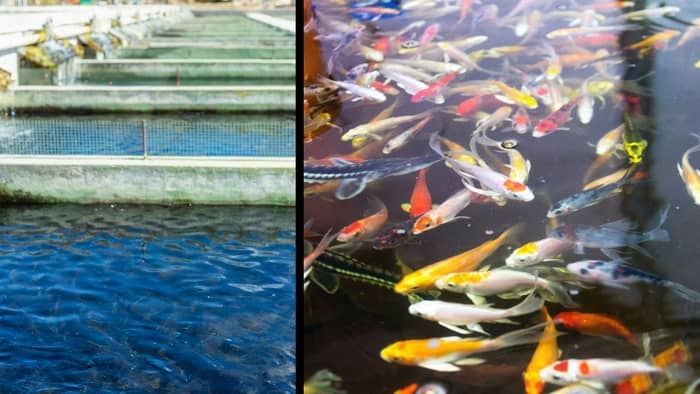Last Updated on October 20, 2022 by Griselda M.
Every practitioner of aquaponics will have their aquaponics grow bed calculator and ratios based on observable or calculable factors. Aquaponics grow bed calculators define the ratio between the amount of fish and plants in your system. This ratio comes from the nutrient input from the aquaculture unit and the utilization of nutrients by the plants. I follow Dr. Lennard’s ratios because of how defined the nutrient flow and processes are.
A lot of different aquaponics practitioners do not have a firm grasp of the processes that happen in the water due to the knowledge required. Aquaponics may seem like a simple system, but practitioners often forget that aquaponics combines two practices that require years of experience. Both aquaculture and hydroponics require intensive research and practical experience for a successful system. The aquaponics fish tank gallons to grow bed ratio combines these two concepts for a successful aquaponics setup.
Aquaponics Grow Bed Calculators
Aquaponics Grow Bed Calculators Should Be Based On The Nutrient Input From Aquaculture To The Number Of Plants In Hydroponics:
You can’t accurately compute the number of nutrients that are inputted into the system from the fish tank volume. According to Dr. Lennard, the ratio between your hydroponics and aquaculture should be based on the amount of feed for fish and the number of plants in the system. How many fish tank gallons to grow bed ratio will take steps to correctly determine before setting up the system.
Dr. Wilson Lennard and Dr. James Rakocy, both define the nutrient input as the daily amount of fish feed. The difference between their approach is in defining the hydroponics component. Dr. Lennard’s practice bases itself on the number of plants and the plant species.
Alternatively, Dr. James Rakocy relates the amount of daily fish feed to the growing area. These two practices are scientifically based and show great results in my experience.
Calculating ratio
Before calculating the ratio, it is important to first identify the characteristics and purpose of your system. In defining the aquaponics grow bed calculator, begin by identifying the following:
- The purpose and objective of your aquaponics system as a commercial setup or backyard setup. For a commercial setup, further, identify your market and main product
- Decide on the plant species, population, and corresponding spacing for the intended species.
- Outline the total growing area needed for the intended plant population
- Determine the total plant nutrient requirement for the hydroponics component based on the species and total population of the plants.
- Define the number of feeds that will be inputted into the system based on the total plant nutrient requirement
- Get the amount of fish in terms of total biomass needed to consume the amount from the daily feeding requirement.
- Determine fish stocking density for your aquaculture component
- Determine the volume of water needed for the fish tank in gallons

Learn more about: How Many Fish Can You Put In A 5 Gallon Tank
From the information defined in these steps, you will be able to choose between the practices of Dr. Rakocy or Dr. Lennard. I only follow Dr. Lennard’s practice since most of the systems I design are aimed toward commercial production. Dr. Rakocy’s system works well with backyard and hobbyist-scale aquaponics which use different plant species.
Nutrients Per Square Foot Of Growing Space
For Hobbyists and Small-Scale Systems With Various Plant Species, The Aquaponics Grow Bed Calculator Of UVI/Rakocy Sufficiently Provides Enough Nutrients Per Square Foot Of Growing Space.
Dr. James Rakocy defines his approach on the available amount of nutrients for the plants per growing area coming from the daily input of feed. For raft-type aquaponics grow beds, the optimum feeding ratio is 2-3 oz per yard2 daily. If you are using an NFT system, you will only need 25% of what is needed in a raft system.
He emphasizes the need to supplement plant nutritional requirements with calcium, potassium, and chelated iron. In the case of the UVI approach, the rate of feeding depends on the plant species as well. Plants with low nutrient requirements can opt to go for a feeding ratio of 2 oz per square yard daily.
Alternatively, plants with larger nutritional requirements like tomatoes and fruiting crops should use 3 oz per square yard daily. In this approach, you will get an excess of nitrogen in your system. This can easily be addressed through the removal of solid waste and daily dilution of water.
Commercial Setups For Aquaponics
These Should Follow The Approach Of Dr. Lennard For The High Specificity and Efficiency Of Production.
Dr. Rakocy focuses on utilizing the fish feed to provide most of the nutrient requirements for the plants other than potassium, calcium, and iron. On the other hand, Dr. Lennard’s approach focuses on balancing the nitrogen required for plant growth. The result is a highly specific approach that requires research into the specific nutrient requirement of each plant species.
This requires the supplementing of additional essential nutrients like phosphorus. Overall this is a more economical approach for commercial systems. For a rough calculation of the ratio of this approach, follow these steps
- From daily feeding amount and protein content, get the amount of nitrogen available for your system
- Identify your plant species and the nitrogen requirement for the plant
- Compute the number of plants that could be grown with the available nitrogen in your system
This process can be worked backward as well starting from the nitrogen requirement for the plants to the required daily feeding amount and protein content. Dr. Lennard has summarized this ratio into a calculator which includes the required biofilter for nitrogen fixation on his website.
Every practitioner will have their aquaponics grow bed calculator based on different variables. Before beginning to calculate your grow bed ratio, start by defining your system’s goals. Then you can begin with either your plant’s nutritional requirements or the number of nutrients from fish feeds.
Dr. Rakocy and Dr. Lennard both approach their aquaponics to grow bed calculators scientifically based on years of research and experimentation. Depending on your plant species, fish species, and purpose for aquaponics, there will be appropriate ratios and calculators.
Read more about:Aquaponics Growing Medium

Candace is an aquaponics expert with over 5 years of experience in the field. She has a degree in environmental science from the University of California, Berkeley and a degree in aquaponics from the University of Florida. She is passionate about sustainable agriculture and has a deep knowledge of aquaculture and hydroponics. She has worked on numerous projects and has been involved in the development of aquaponic systems and fish farms. She also has experience in designing and constructing aquaponic systems. With her expertise, Candace is able to advise clients on the most effective and efficient way to construct and manage their aquaponic system. She is an active member of the aquaponic community, often speaking at conferences and seminars. Candace is dedicated to helping others understand the importance of aquaponics, and she is a strong advocate for sustainable food production.


Leave a Reply
You must be logged in to post a comment.